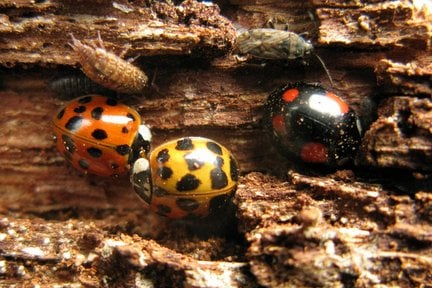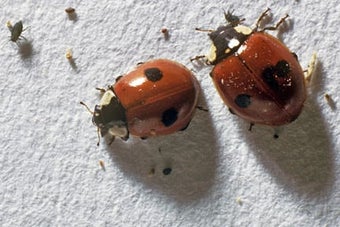
Quick facts
Common name - Harlequin ladybird
Scientific name - Harmonia axyridis
Distribution - Arrived in UK in 2004, now widespread
Food - Aphids and other insects
What is a harlequin ladybird?
The harlequin ladybird is one of about 40 species of ladybird found in Britain and Ireland. Like many other ladybirds it is predatory. It has a preference to feed on aphids but will eat other insects.
The harlequin ladybird originates from Japan and has been introduced as a biological control agent around the world to control aphids. It was not deliberately introduced to Britain or Ireland, but it become established in 2004. Since then it has become widespread in England and is spreading in Wales, Scotland and Ireland.
Sightings of harlequin and other ladybirds can be submitted to the UK ladybird survey.
Adult harlequin ladybirds are 8-10 mm in length, and are very variable in colour and markings. The two most common forms are black with two red spots or orange with 18 black spots. Some of the more than 40 species of ladybird to the UK also have many colour forms. Some of these native ladybirds can appear similar to those of the harlequin ladybird and it is often not easy to determine which species has been found. For example, the native two-spot ladybird and ten-spot ladybirds have many colour forms but can be distinguished by size; the two-and ten-spot ladybirds are small at 4-5 mm in length.
Harlequin ladybird larvae are black and orange reaching up to about 1 cm (½ in) in length. They also feed on aphids and other insects. Ladybird larvae all generally have the same elongate body shape and most are black or dark grey. Some have yellow or orange markings and some have hairs or spikes. The charcoal grey harlequin larvae is characterised by having two orange stripes and being spikey.
Harlequin ladybird pupa like other ladybird pupa is immobile and can often be found attached to plants. It is rotund and about 8 mm in diameter. The pupae are dark in colour with some orange/red markings and very similar to the pupa of the native seven spot ladybird.
Harlequin ladybird eggs are yellow/orange and laid in groups on leaves, they are approximately 1-2 mm in length and not readily distinguished from the eggs of other ladybirds.

Is harlequin ladybird a problem?
As with many other ladybirds, harlequin ladybird primarily feeds on aphids and so can be considered a useful addition to garden insect fauna. However, this ladybird will also feed on many other insects, including scale insects, eggs and larvae of butterflies and moths, other small insects including other ladybirds and it can be cannibalistic. There was a fear that the harlequin ladybird will out-compete some of the aphid predators and lead to a decline in their numbers. Evidence in Britain so far is mixed with some native ladybirds showing no declines in the presence of the harlequin and others becoming less common; research is on-going. This is similar to the experience in parts of the USA where the harlequin ladybird was originally introduced from Japan as a biological control for aphids.
Harlequin ladybirds in buildings
Many species of ladybird like to overwinter in groups inside buildings, the harlequin is no exception, The appearance of large groups of this beetle indoors can cause some concern. There is however, no danger associated with the presence of these ladybirds although they can exude a clear yellow liquid which may cause some staining to furnishings. Unfortunately it is not possible to discourage the ladybirds from entering buildings and they can be captured and removed or tolerated.
Management
There are no means of controlling harlequin ladybirds, since any actions taken against them would also be harmful to ladybirds, other aphid predators and other insects. In addition, they are now so well established and abundant that destroying a few in one area will not make any difference to their overall numbers.
When found in buildings the ladybirds can be tolerated or captured and released out of doors.
Biology
Harlequin ladybirds overwinter in sheltered places often in large groups, including inside buildings.
In spring the adults emerge and disperse, mate and lay eggs, usually on plants hosting aphids. The larvae feed on aphids and other insects before pupating after two to three weeks. Development from egg laying adult to egg laying adult can be about a month in warm weather and there can be several generations a year.
In autumn adults seek overwintering sites and can form large aggregations, these can become particularly evident on the south side of buildings and other structures.





